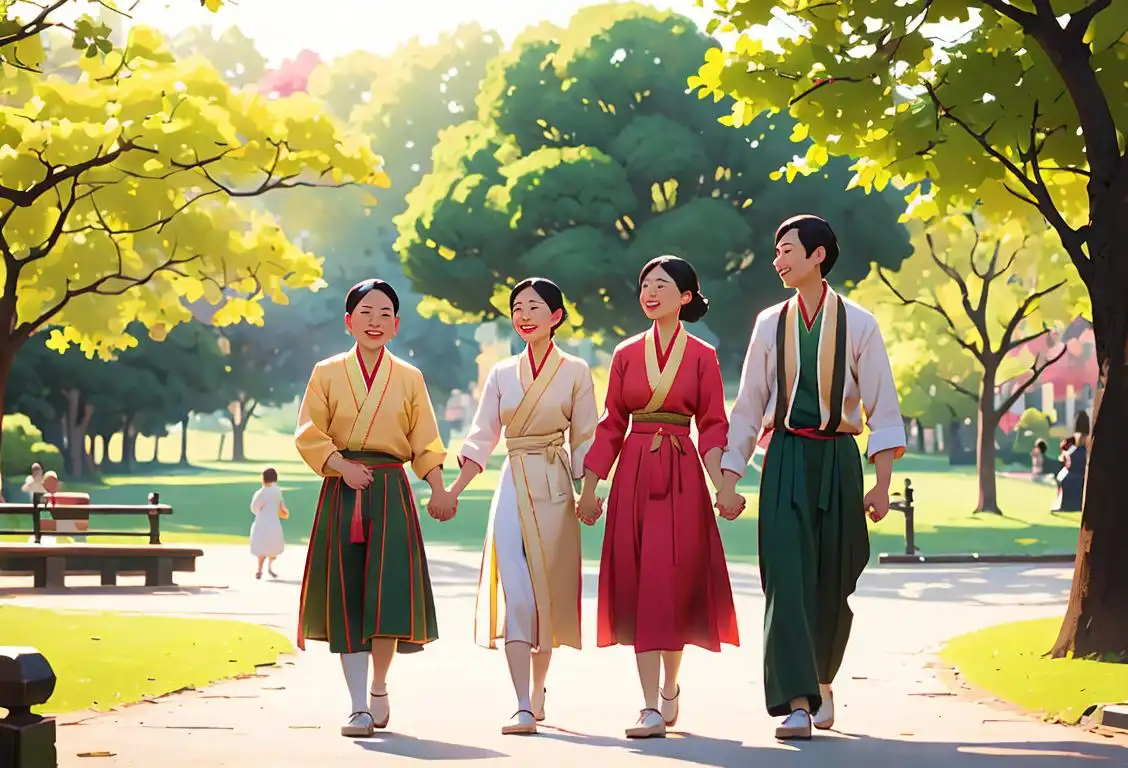National Reunification Day

Welcome to the fascinating world of National Reunification Day! Prepare yourself for a journey through history, celebration, and a little fun along the way.
When is Reunification Day?
It's national reunification day on the 30th April.
What is National Reunification Day?
National Reunification Day is a momentous occasion that commemorates the reunification of a nation. This joyous day marks the coming together of people who were once divided and celebrates the unity and strength of a nation.
One noteworthy celebration of National Reunification Day happened on April 30, 1975. This day marked the fall of Saigon and the end of the Vietnam War, leading to the reunification of North and South Vietnam. It was a monumental event that brought an end to a long and devastating war, and reunited the Vietnamese people.
Throughout the years, countries around the world have recognized National Reunification Day to celebrate their own reunification or to show solidarity with other nations. It's a day to reflect on the importance of unity, peace, and the bonds that bring people together.
How to Celebrate National Reunification Day
Celebrating National Reunification Day can take many forms, depending on the historical context and cultural traditions associated with each specific celebration. Here are a few ideas for honoring this special day:
- Organize a gathering of loved ones to share stories of overcoming divisions and coming together.
- Prepare a feast inspired by traditional foods from the reunified nation. Food has a unique way of bringing people together and celebrating culture.
- Engage in activities that promote unity and teamwork, such as playing sports or participating in team-building exercises.
- Take a moment to remember the challenges faced during the process of reunification and appreciate the peace that has been achieved.
Did You Know?
Did you know that National Reunification Day is a great opportunity to learn more about the history and struggles of different nations? Take some time to explore documentaries, books, or online resources to deepen your understanding of these significant events.
History behind the term 'Reunification'
1945
The Division Begins
Following World War II, Germany was divided into four zones, each occupied by one of the victorious Allied powers: the United States, the Soviet Union, Great Britain, and France. This division marked the beginning of the term 'reunification' as it set the stage for the eventual coming together of the divided nation.
1945
The End of World War II
Following the end of World War II in 1945, the term 'reunification' began to gain significance. As nations around the world worked towards rebuilding and recovering from the war's devastation, the concept of bringing together divided regions and populations became increasingly important.
1945
End of World War II
The term 'reunification' gained significance following the end of World War II in 1945. This global conflict led to the division of many countries, including Germany and Korea. The idea of reunifying these divided nations started to emerge as a means of restoring peace and stability.
1945
End of World War II
Following the surrender of Nazi Germany in May 1945, the world entered a period of post-war reconstruction. One of the significant consequences of World War II was the division of several nations, particularly Germany and Korea, into separate zones of occupation by the victors: the United States, Soviet Union, Great Britain, and France.
1950
Korean War
In 1950, the Korean War erupted, leading to the division of Korea into North and South along the 38th parallel. This division heightened the desire for reunification and sparked discussions on how to achieve it. The term 'reunification' became a key goal for both North and South Korea, despite the ongoing conflict.
1949
Division of Germany
In the aftermath of World War II, Germany was divided into two separate states: East Germany (German Democratic Republic) aligned with the Soviet Union in the east, and West Germany (Federal Republic of Germany) allied with the Western nations in the west. This division represented the beginning of the separation and ongoing struggle for reunification.
1949
The Division of Germany
In 1949, Germany was divided into two separate nations: West Germany and East Germany. This division led to the idea of reunifying the two parts and restoring a single, unified Germany. The desire for reunification became a major topic in the following decades.
1953
East and West Germany Established
With tensions rising between the Soviet Union and the Western Allies, the German Democratic Republic (East Germany) was established in 1949 under Soviet influence, while the Federal Republic of Germany (West Germany) was created as a result of the merging of the British, American, and French zones. This step further solidified the concept of reunification as it highlighted the existence of two separate German states.
1952
Korean Armistice Agreement
In 1952, the Korean Armistice Agreement was signed, bringing an end to major hostilities in the Korean War. However, it did not result in a reunification of the two Koreas. Nonetheless, the agreement laid the groundwork for future discussions and negotiations aimed at achieving reunification.
1961
The Berlin Wall is Erected
In an effort to prevent East Germans from bypassing the heavily guarded border and defecting to the West, the East German government constructed the Berlin Wall in 1961. This physical barrier marked a highly visible symbol of the separation between East and West Germany and served to highlight the need for reunification in the eyes of many.
1953
East German Uprising
On June 17, 1953, East Germany experienced an unprecedented popular uprising against the ruling Socialist Unity Party. Protesters demanded political freedom, democracy, and reunification with West Germany. However, the Soviet Union, who controlled East Germany, suppressed the revolt, which temporarily hindered the reunification process.
1989
The Fall of the Berlin Wall
One of the most significant moments in the history of reunification occurred in 1989 with the fall of the Berlin Wall. This iconic event marked the symbolic end of the Cold War and signaled the possibility of reunification for Germany. The destruction of the barrier that had physically separated families and friends for decades became a powerful symbol of the reunification process.
1989
Fall of the Berlin Wall
Amidst widespread demonstrations and public pressure, the Berlin Wall finally fell on November 9, 1989. This monumental event led to a wave of euphoria and hope for reunification. It symbolized the opening of communication and travel between East and West Germany, laying the groundwork for the reunification process.
1989
Fall of the Berlin Wall
The fall of the Berlin Wall on November 9, 1989, marked a crucial turning point in German history. This highly symbolic event initiated the process of reunification by symbolizing the end of the Cold War division between East and West Germany that had lasted for nearly four decades.
1990
German Reunification
On October 3, 1990, West Germany and East Germany were formally reunited as a single nation, bringing an end to the division that had lasted for over four decades. This historic event was celebrated by millions of Germans and marked a significant milestone in the process of reunification.
1989
Fall of the Berlin Wall
The reunification of Germany became a major milestone in the history of the term 'reunification.' In 1989, the Berlin Wall, which had divided East and West Germany for nearly three decades, fell. This event symbolized the end of the Cold War era and paved the way for the reunification of the two German states.
1990
Reunification of Germany
On October 3, 1990, the formal reunification of East and West Germany took place, putting an end to the division that had lasted for over four decades. The process involved negotiations between the two German states as well as the international community, ultimately resulting in the dissolution of the German Democratic Republic and the establishment of a single, unified Germany.
2002
Korea's Reunification Aspiration
The term 'reunification' also gained prominence in relation to the Korean Peninsula. Although the division between North and South Korea occurred in 1945, the desire for reunification has been ongoing. In 2002, both North and South Korea jointly declared their aspiration for peaceful reunification, highlighting the enduring importance of the concept.
1990
German Reunification
In 1990, East and West Germany officially reunited, ending over 40 years of division. This momentous event provided a tangible example of the term 'reunification' being realized on a national scale. The German reunification process served as an inspiration for other divided nations striving for reunification.
1990
German Reunification
Following the fall of the Berlin Wall, negotiations between East and West Germany, along with international actors, led to the official reunification of Germany on October 3, 1990. This event marked the end of the division and the emergence of a single, unified German state.
1991
Reunification Rallies in Korea
Throughout the 1990s, various reunification rallies were held in South Korea, with thousands of people expressing their desire for the reunification of North and South Korea. These rallies showcased the persistent longing for reunification and kept the term in public consciousness.
2000
June 15th North–South Joint Declaration
In the year 2000, the leaders of North and South Korea signed the June 15th North–South Joint Declaration. This declaration reaffirmed the commitment of both nations to work towards reunification through peaceful means. It marked a significant step forward in the diplomatic efforts to achieve reunification.
Did you know?
Did you know that National Reunification Day is a great opportunity to learn more about the history and struggles of different nations? Take some time to explore documentaries, books, or online resources to deepen your understanding of these significant events.Tagged
awareness food loved ones remembrance sportsFirst identified
11th April 2015Most mentioned on
30th April 2017Total mentions
163Other days
Records In Single Day
Team As He Gets Ready To Open His Shop For The Day
Security Day
Odp Day
Ojd Day
Diaspora Day
Suicide Prevention Month Day
Foundation Day
Awareness Day
Total Every Day









